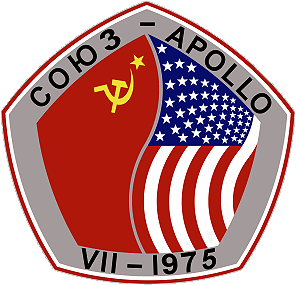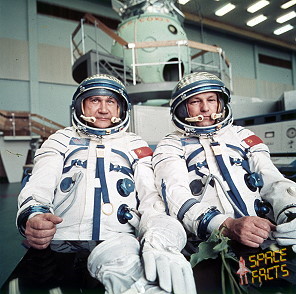Human Orbital Spaceflights
![]()
International Flight No. 54Soyuz 19 EPASSoyuzUSSR |
 |
 |
 |
||
![]()
Launch, orbit and landing data
walkout photo |
 |
|||||||||||||||||||||||
alternative crew photo |
alternative crew photo |
|||||||||||||||||||||||
alternative crew photo |
alternative crew photo |
|||||||||||||||||||||||
alternative crew photo |
alternative crew photo |
|||||||||||||||||||||||
Crew
| No. | Surname | Given names | Position | Flight No. | Duration | Orbits | |
| 1 | Leonov | Aleksei Arkhipovich | Commander | 2 | 5d 22h 30m 51s | 97 | |
| 2 | Kubasov | Valeri Nikolayevich | Flight Engineer | 2 | 5d 22h 30m 51s | 97 |
Crew seating arrangement
|
 |
|
||||||||||||
Backup Crew
|
 |
|||||||||||||||
alternative crew photo |
||||||||||||||||
alternative crew photo |
||||||||||||||||
alternative crew photo |
Hardware
| Launch vehicle: | Soyuz-U (No. F15000-17) |
| Spacecraft: | Soyuz 19 (7K-TM No. 75) |
Flight
|
Launch from the Baikonur Cosmodrome and
landing 61 km northeast of Arkalyk. This mission was the first joint U.S.–Soviet space flight, and the last flight of an Apollo spacecraft. Its primary purpose was as a symbol of the policy of détente that the two superpowers were pursuing at the time, and marked the end of the Space Race between them that began in 1957. The Soyuz and Apollo flights launched within seven-and-a-half hours. The Apollo Command/Service Module (CSM) was launched with a docking module specially designed to enable the two spacecraft to dock with each other, used only once for this mission. The docking module was designed as both an airlock - as the Apollo was pressurized at 5.0 psi using pure oxygen, while the Soyuz used a nitrogen/oxygen atmosphere at sea level pressure - and an adapter, since the surplus Apollo hardware used for the ASTP mission was not equipped with the APAS docking collar jointly developed by NASA and the Soviet Academy of Sciences for the mission. One end of the docking module was attached to the Apollo using the same "probe-and-drogue" docking mechanism used on the Lunar Module and the Skylab space station, while its other end had the APAS docking collar, which Soyuz 19 carried in place of the standard Soyuz/Salyut system of the time. The APAS fitting with the Soyuz 19 was releasable, allowing the two spacecraft to separate. The docking with the US Apollo spacecraft ASTP occurred on July 17, 1975. It was the first docking of two spacecrafts, launched from different nations. Thomas Stafford and Donald Slayton meanwhile had entered the docking module and closed behind them the hatch leading to the CSM. They raised the pressure from 255 to 490 millimeters by adding nitrogen to the previously 78 percent oxygen atmosphere. In Soyuz, the crew had reduced the cabin pressure to 500 millimeters before the docking. The pressure in the tunnel between the docking module hatch and the Soyuz hatch had been raised from zero to equal that of the docking module. Aleksei Leonov and Valeri Kubasov were the first to open the hatch leading to the international greeting. During the transfer that was to follow, the pressure in the DM and Soyuz would be the same - 510 millimeters. Then at 2:17:26 p.m. on the July 17, 1975, Thomas Stafford opened the hatch, which led into the Soyuz orbital module. The crewmembers rotated between both spacecrafts and performed material experiments. The mission included both joint and separate scientific experiments, and provided useful engineering experience for future joint US-Russian space flights. While the two ships were docked, the three Americans and two Soviets conducted joint scientific experiments, exchanged flags and gifts (including tree seeds which were later planted in the two countries), signed certificates, visited each other's ships, ate together, and conversed in each other's languages. (Because of Thomas Stafford's pronounced drawl when speaking Russian, Aleksei Leonov later joked that there were three languages spoken on the mission: Russian, English, and "Oklahomski.") There were also docking and redocking maneuvers, during which the two spacecraft reversed roles and the Soyuz became the "active" ship. After being docked for nearly 44 hours, Apollo and Soyuz parted for the first time and were station-keeping at a range of 50 meters. The Apollo crew placed its craft between Soyuz and the sun so that the diameter of the service module formed a disk which blocked out the sun. This artificial solar eclipse, as viewed from Soyuz, permitted photography of the solar corona. After this experiment Apollo moved towards Soyuz for the second docking. Three hours later Apollo and Soyuz undocked for the second and final time. The spacecraft moved to a 40 m station-keeping distance so that the ultraviolet absorption (UVA MA-059) experiment could be performed. This was an effort to more precisely determine the quantities of atomic oxygen and atomic nitrogen existing at such altitudes. Apollo, flying out of plane around Soyuz, projected monochromatic laser-like beams of light to retro-reflectors mounted on Soyuz. On the 150-meter phase of the experiment, light from a Soyuz port led to a misalignment of the spectrometer, but on the 500-meter pass excellent data were received; on the 1,000-meter pass satisfactory results were also obtained. The Soyuz spacecraft is composed of three elements attached end-to-end - the Orbital Module, the Descent Module and the Instrumentation/Propulsion Module. The crew occupied the central element, the Descent Module. The other two modules are jettisoned prior to re-entry. They burn up in the atmosphere, so only the Descent Module returned to Earth. The deorbit burn lasted 188 seconds. Having shed two-thirds of its mass, the Soyuz reached Entry Interface - a point 400,000 feet (121.9 kilometers) above the Earth, where friction due to the thickening atmosphere began to heat its outer surfaces. With only 23 minutes left before it lands on the grassy plains of central Asia, attention in the module turned to slowing its rate of descent. Eight minutes later, the spacecraft was streaking through the sky at a rate of 755 feet (230 meters) per second. Before it touched down, its speed slowed to only 5 feet (1.5 meter) per second, and it lands at an even lower speed than that. Several onboard features ensure that the vehicle and crew land safely and in relative comfort. Four parachutes, deployed 15 minutes before landing, dramatically slowed the vehicle's rate of descent. Two pilot parachutes were the first to be released, and a drogue chute attached to the second one followed immediately after. The drogue, measuring 24 square meters (258 square feet) in area, slowed the rate of descent from 755 feet (230 meters) per second to 262 feet (80 meters) per second. The main parachute was the last to emerge. It is the largest chute, with a surface area of 10,764 square feet (1,000 square meters). Its harnesses shifted the vehicle's attitude to a 30-degree angle relative to the ground, dissipating heat, and then shifted it again to a straight vertical descent prior to landing. The main chute slowed the Soyuz to a descent rate of only 24 feet (7.3 meters) per second, which is still too fast for a comfortable landing. One second before touchdown, two sets of three small engines on the bottom of the vehicle fired, slowing the vehicle to soften the landing. The landing was without any problems, only 6 km far from its aim point. |
Photos / Graphics
 |
 |
 |
 |
 |
 |
 |
 |
 |
 |
 |
 |
 |
 |
 |
 |
| © |  |
Last update on August 12, 2020.  |
 |